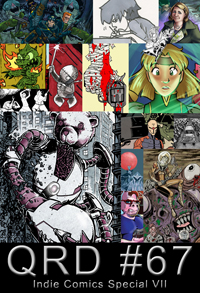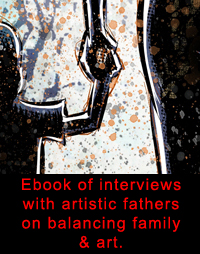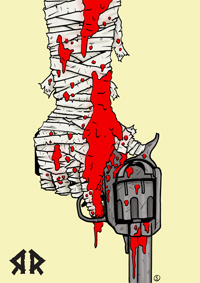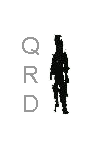
March 2014

City: Weymouth, MA
Comics: Return to Rander, Memoirs of the Mysterious, Between the Devil & the Deep Blue Sea
Websites: www.tonysedani.com
QRD – How old were you when you first got into comics & did you always stick with them or did you come back to them?
Tony – I can’t remember a time in my life that didn’t involve comic books. None of my immediate family even remotely cared about comics. But to keep me occupied, my family always purchased them for me. I kept my collection together & would frequently read/look through them over & over. & from then, I have always had at least the slightest interest even at times of my life that I would start to move away, I would still maintain a collection.
QRD – What was the first comic book you ever bought?
Tony – My earliest memories of buying comic books go back to my great-grandmother buying me Superman, Detective Comics, & Amazing Spider-Man issues off of the comic rack at grocery stores. It was always a treat & something I looked forward to.
QRD – How old were you when you put out your first comic?
Tony – My first creator owned comic was put out when I was 11 years old. It was entitled Bolak & was terrible. But my friends at school seemed to dig it! Since then, I have created & abandoned comics for years. My first “real” comic that was self-published was Between the Devil & the Deep Blue Sea with my buddy Joe Daxberger when I was 29. It is an anthology book based on the sea.
QRD – What decade do you think produced the best comics?
Tony – Personally I think that the current decade is seeing some of the most creative & fresh comic books. The past few decades have been focused on the big 2 characters & rehashes & re-releases. With the market opening up so much & publishers like Image & Darkhorse, I can go find a unique comic book that hasn’t been done before every Wednesday.
QRD – Why comics instead of just writing or drawing?
Tony – They say a picture is worth a thousand words, well what about a book full of sequential pictures!? Comics has so much going for it that to just make pinups or single images just wouldn’t fulfill that story telling desire I have.
QRD – Do you see mini-comics & indie comics as paths to mainstream comics or as their own unique media?
Tony – Nowadays, I think making indie comics can be self-sufficient with the rise of the internet. The proof is in the pudding & if you have something that appeals to millions of people, they will find it via twitter, tumblr, or reddit.
QRD – How many copies of your comic do you print in your first run?
Tony – My first issue of Return to Rander was a successful Kickstarter & allowed me to print 500.
QRD – How many books do you produce a year & how many would you like to?
Tony – I produce about 3 books a year & would like to produce 12 if I could do it full-time.
QRD – Do you think stories should be serialized or delivered as complete works?
Tony – The comic industry is great for both! Serialized give us that episodic suspense. We follow it like a good TV show. & there are also stories you may have missed & wait for a complete work to be published & have the opportunity to dive in head first with a full story. I pick & choose the stories I want to read serialized or through trade paperback based on what kind of writer it is.
QRD – How long is it from when you start a comic until it’s printed?
Tony – It takes me about 4 months from beginning to end encapsulating writing, thumb-nailing, penciling, inking, scanning, graytoning, lettering, & layout.
QRD – What do you do better with your comics now than when you first started?
Tony – Time management & meeting deadlines is something that just gets easier for me.
QRD – Do you do thumbnails?
Tony – Yes, I have to have a visual idea of how it will look ahead of time. But only I understand what is going on in my thumbnail.
QRD – At what size do you draw?
Tony – 11” x 17”.
QRD – What kind of pens do you use?
Tony – Copic tech pens & brush pens.
QRD – What does your workstation look like?
Tony – Simple, clean & bright.
QRD – At what point in the artistic process do you work digitally?
Tony – At the very end I gray tone my art, fix any problems, & digitally letter.
QRD – What do you think of digital comics & webcomics?
Tony – I personally like traditional media, but you cannot deny how impressive the technology is. But I don’t think anything will ever impress me as much as seeing an original page done with good old-fashioned tools.
QRD – Do you prefer working in color or black & white?
Tony – Black & white. I don’t know if it is because I am an artist, but I always love to read a nice black & white story so I can see the artist’s lines more vividly & in turn I like to create my art that way.
QRD – How many different people should work on a comic & what should their jobs be?
Tony – I find myself enjoying comics that have as little cooks in the kitchen as possible. Just knowing this is the sole vision of a creator can impress me more than having 4 all-star creators on one book.
QRD – How tight do you think a script should be as far as telling the artist what to draw?
Tony – Personally, to work off someone’s script, I think being too tight can make the artist feel like a monkey. Leave the artist room to be creative & layout a panel how they see best.
QRD – What do your friends & family think of your comics?
Tony – My family thinks they are too violent, but I always say to them, the newspaper is much more violent than my comic on any given day.
QRD – What do you think of superheroes?
Tony – I love superheroes! But I love a simple superhero. I think Batman would be such a better comic book if it didn’t share a universe with hundreds of others.
QRD – Marvel or DC?
Tony – Image?
QRD – What comic characters other than your own would you like to work with?
Tony – Teenage Mutant Ninja Turtles. I love the dynamic of four different characters forced to be together because they are brothers & freaks of nature.
QRD – What conventions do you try to attend & why?
Tony – I like to try & attend Boston Comic Con every year since it is my local big show. I also like to attend any small press shows, including MICE & Small Press Expo as I really enjoy the interest in alternative comics that the attendees have.
QRD – How do you feel about doing work for anthologies?
Tony – I think anthologies are a great way to meet new creators & have fun & try new things with little worry. I also like to read anthologies as they are easy to jump in & out of at any time.
QRD – What do you do to promote your books?
Tony – Social media outlets & simple advertising through local brick & mortar shops. Conventions also help a lot to be seen.
QRD – Do you think your comics are well suited to comic shops or would sell better elsewhere?
Tony – I don’t think they fit in with the big 2 at all, but I like to think that I have a small amount of people out there that make it a point to buy my book on new comic day when it is released.
QRD – What other medium would you like to see some of your comics made into (television, film, games, action figures, etc.)?
Tony – I would like to see my comic as mystery card game.
QRD – Do you consider yourself a comic collector or a comic reader or both?
Tony – Definitely both. Art inspires art!
QRD – What do you see as the most viable mediums for comics distribution 10 years from now?
Tony – I do not see physical comics as a dinosaur like a lot do. Reading a novel digitally & reading a comic digitally are two entirely different things. Physical novels will disappear, but comic books will remain. I argue my case by saying that if you take a physical comic book & go sit by a fire in a dimly lit room & dive in, you can’t have that same connection to the book if you are reading it on a bright backlit tablet. We are removing an important connection there. Ink on paper.









